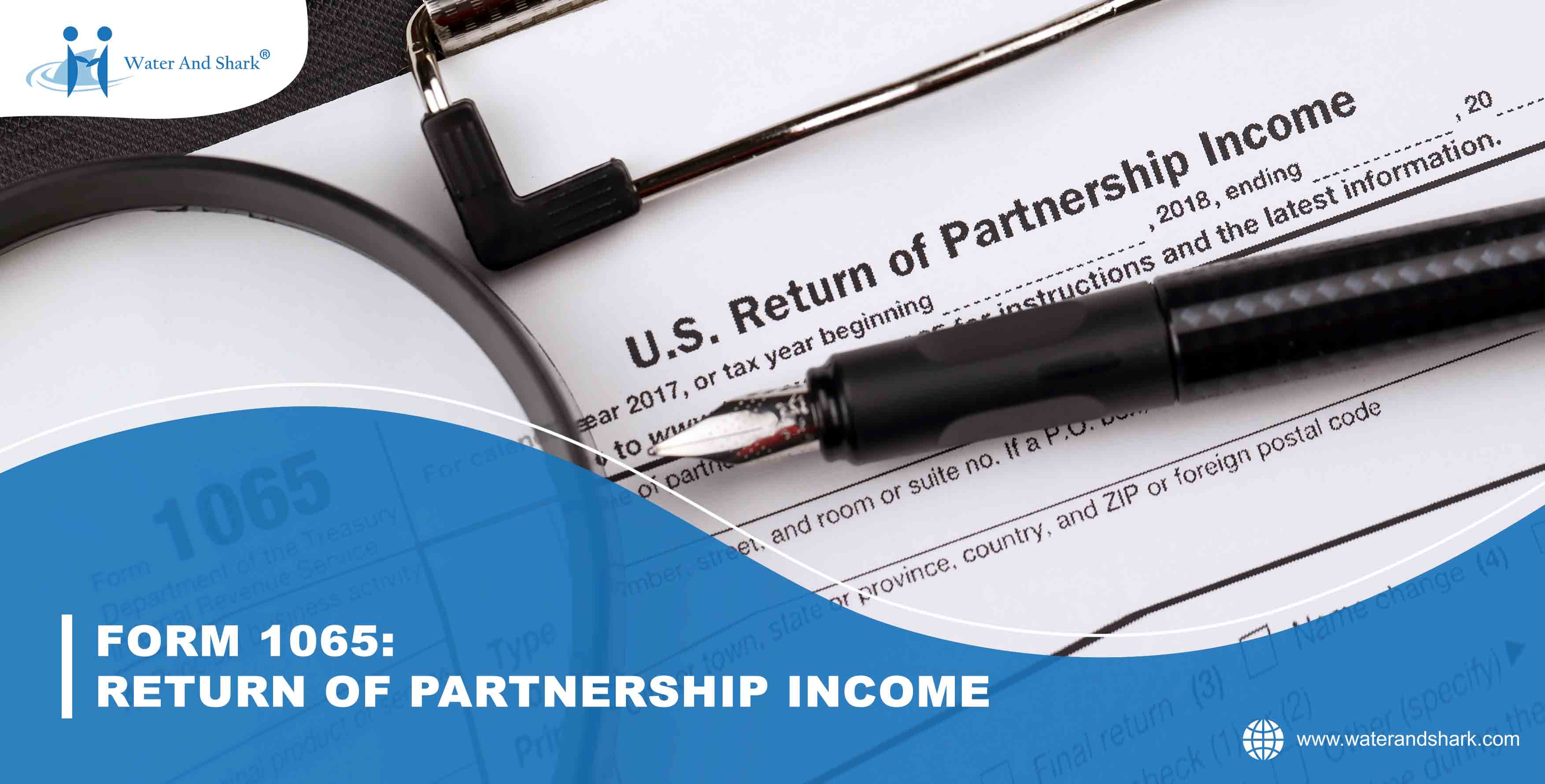FORM 1065: Return of Partnership Income
March 01, 2024 waterandshark
Navigating the tax requirements of business partnerships can be challenging. Within this landscape, Form 1065: Return of Partnership Income holds significant importance for partners in U.S.-based partnerships. This document serves as a crucial tool for reporting partnership income to the Internal Revenue Service (IRS) and plays a central role in the tax management strategy of these entities. Understanding the intricacies of Form 1065 and its associated schedules is essential for partners to fulfil their tax obligations accurately and efficiently, ensuring compliance while maximizing financial efficiency.
Jump right in:
Understanding Form 1065
Requirements of filing form 1065
FAQs
Understanding Form 1065:
A partnership is when two or more people join together to run a business. They each contribute capital in the form of money, property, work, or skills, and they all share in the business's profits and losses. Partnerships operate on a unique model where profits and losses are distributed among partners based on their agreed-upon terms outlined in the partnership agreement they are also called Pass-through entities. All the partnership including general partnership, LLC, and Limited Liability Partnership shall file form 1065.
Form 1065 enables partnerships to report these financial details collectively to the IRS. By doing so, it offers a thorough overview of the partnership's financial health for the tax year, including revenue, expenses, and overall profitability. This comprehensive snapshot aids both the partnership and the IRS in understanding the partnership's financial standing and facilitates accurate tax reporting.
Reporting on Form 1065
A partnership files an annual information return to report its financial activity, including income, deductions, gains, and losses. However, the partnership itself does not pay income tax. Instead, it distributes profits or losses to its partners, who then report their share on their personal tax returns. As partners are not considered employees, they do not receive Form W-2. Instead, the partnership provides each partner with a copy of Schedule K-1 (Form 1065), detailing their portion of the partnership's income or loss.
Contents of Form 1065
The initial section of Form 1065 (A through K) collects essential general information about the partnership, including tax year, name, address, business activity, EIN, start date, total assets, return type, accounting method, number of Schedule K-1 forms attached, and if applicable, the inclusion of Schedule C or M-3 forms.
Schedule B of Form 1065 is a detailed section with 29 line items extending onto page 3, labeled "Other information." It requires yes or no responses and details about the partnership. Initial questions cover entity type, ownership percentages, partnership debt, foreign financial accounts, and investments. Specific information tailored to each business is needed, emphasizing the importance of organized financial data and consultation with a tax professional. Subsequent questions address partnership property, foreign partners, and tax obligations, providing a comprehensive examination of the partnership for accurate tax filing.
After completing Schedule B, the subsequent step is filling out Schedule K of Form 1065. Unlike Schedule K-1, which details each partner's individual share, Schedule K provides an overview of all partners' shares regarding the partnership's income, credits, and deductions. It's essential to include a copy of each partner's K-1 with Form 1065.
Schedule L in Form 1065 requires partnerships to report their balance sheet as per their internal records to the IRS. It follows basic accounting principles and reflects the partnership's assets, liabilities, and partners' equity as of the first and last day of the tax year. The method of accounting (cash or accrual) used by the partnership affects the entries on Schedule L.
Schedule M-1 in Form 1065 addresses differences between the partnership's net income on its financial statements and the net income reported on its tax returns. Discrepancies can arise from factors such as tax-exempt interest, guaranteed payments, and depreciation. This schedule helps reconcile the variations between the two sets of financial data.
Schedule M-2 on Form 1065 reports changes to partners' capital accounts, aiding IRS verification of tax reporting accuracy. It aligns with income reporting and the balance sheet (Schedule L) and should match total amounts on partners' Schedule K-1s. However, not all partnerships complete this analysis, particularly smaller ones.
Schedule K-1 is a federal tax document utilized for reporting income, losses, and dividends to partners in a business, shareholders in an S corporation, and beneficiaries of trusts and estates. Each relevant individual receives a separate Schedule K-1 detailing their share of the income and other financial aspects. The partnership files Form 1065, the S corporation uses Form 1120-S, and trusts or estates use Form 1041 to report the overall activity outlined in the respective K-1 forms. Schedule K-1 necessitates tracking each partner's basis in the partnership, representing their investment or ownership stake. Basis increases through capital contributions and income shares but decreases through losses and withdrawals.
Schedule K-3 (Form 1065) is utilized to report items of international tax significance arising from the operation of a partnership. This information must be included on tax or information returns, where applicable. Specific instructions are provided in separate parts. However, it's important to note that the partner's proper treatment of certain items may depend on information that the partnership lacks. Consequently, the partnership may have reported information on Schedule K-3 based on incorrect assumptions. In such instances, partners are required to treat the items according to their actual facts and, if necessary, file a Form 8082, Notice of Inconsistent Treatment or Administrative Adjustment Request (AAR), to address and clarify any inconsistencies.
Requirements of filing form 1065
A domestic partnership typically needs to submit Form 1065 by the 15th day of the 3rd month following the end of its tax year, as indicated on the form. For partnerships following the calendar year, the deadline is March 15. If this date falls on a weekend or legal holiday in the District of Columbia or the state where the return is filed, the deadline shifts to the next non-weekend/non-holiday day. Hence, calendar year partnerships can file their 2023 partnership year return by March 15, 2024, ensuring timely submission. If the business needs an extension, it must file Form 7004 on or before the due date. When filed by the deadline, the company automatically receives a six-month extension.
Stay on track with Form 1065 filing deadlines and requirements! Visit waterandshark.com for expert guidance on partnership tax compliance tailored to your business needs."
FAQs
1. Why is Form 1065 important for partnerships?
Form 1065 is vital for partnerships as it reports financial details to the IRS, facilitating accurate tax reporting and distribution of profits or losses among partners.
2. What happens if a partnership fails to file Form 1065?
If a partnership fails to file Form 1065, the IRS imposes a penalty of $220 for each month or part of a month (up to 12 months) that the failure continues. This penalty is multiplied by the total number of partners in the partnership during any part of the tax year for which the return is due, as per IRS regulations.
3. What are the different tax credits available for a partnership firm?
Partnership firms may benefit from various tax credits available to businesses, including the Investment Tax Credit, Research and Development Tax Credit, Low-Income Housing Tax Credit, Renewable Energy Tax Credits, Work Opportunity Tax Credit, and Historic Rehabilitation Tax Credit.
4. What are the requirements under Schedule M-2?
The partnership qualifies for certain simplified reporting requirements if its total receipts were less than $250,000, total assets were less than $1 million at the end of the tax year, Schedule K-1s are filed with the return and furnished to partners by the due date (including extensions), and it is not filing or required to file Schedule M-3.





Comment